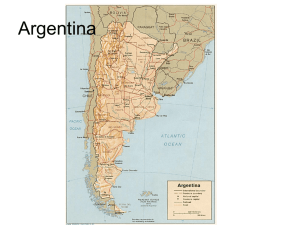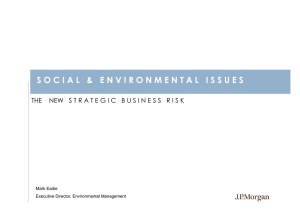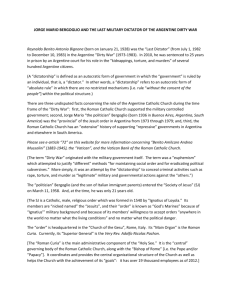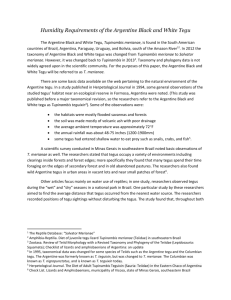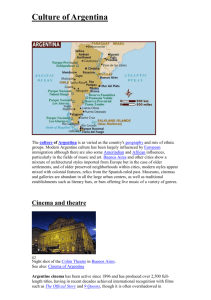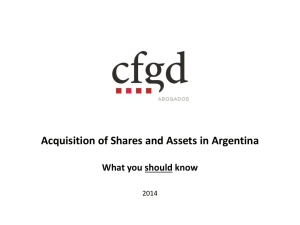Argentina
advertisement
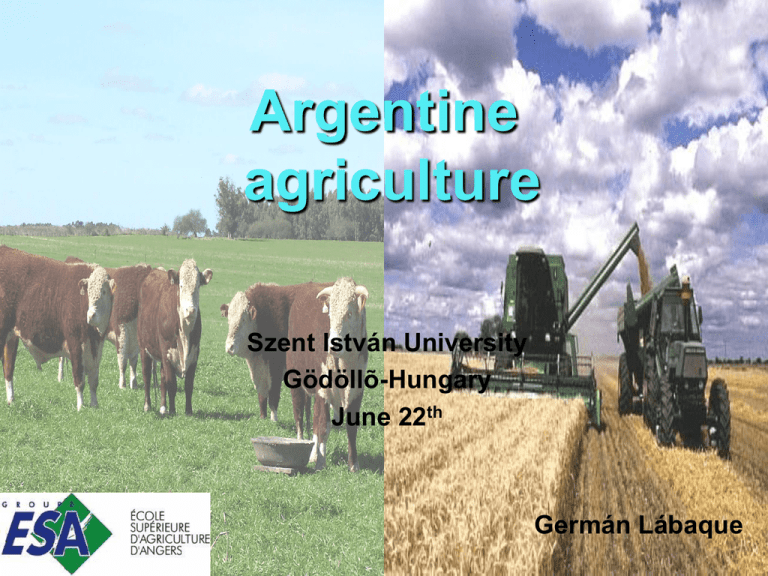
Argentine agriculture Szent István University Gödöllõ-Hungary June 22th Germán Lábaque About Argentina Official name: Argentine Republic Status: Independent country since 1816. Democratic Republic Capital: Buenos Aires Population: 40,060,000 inhabitants Area: 2,766,890 km² (8th largest country) History of Agrofood sector Since the second half of the 19th century, the country followed an agricultural and livestock export model. The 1920s, Argentine exports was 99% of agricultural sector. Maize, wheat and meat were the most important. After second world war, Argentina was an important supplier to Europe to send different foods, especially wheat. the 1976-90 era, led by agricultural exports with the boom in soybean cultivation, displaced sunflower seeds as the leading oilseed crop in 1977. Today Currently, one fifth of Argentine exports is composed of unprocessed agricultural primary soybeans, wheat and maize. goods, mainly A further one third is composed of processed agricultural products, such as animal feed, flour and vegetable oils. Argentine agriculture 7% of all employment. 30 millions hectares of land cultivated The most important crops are cereals and oilseeds. Soybeans: 40 millions tonnes Maize: 20 millions tonnes Wheat: 8 millions tonnes Sunflower: 2,5 millions tonnes Argentine agriculture Other cultures: Apple Pear Sugar Citrus: Orange, lemon, tangerine Tobacco Olive Rice Grape Important fruit production with quality export Argentine agriculture The argentine wine: Argentina is the world’s 5th largest wine producer. 8th in wine consumption The Andean region of the country: Mendoza, Salta, San Juan are the principal regions. There are 1,500 wineries in Argentina, but the two largest companies(Bodega Catena Zapata and Bodega Trapiche) are responsible for nearly 40% of all the wine made in Argentina. World commerce Argentina is one the major producer and exporter of some products: 1st exporter in soya expeller, soya oil and honey 2nd exporter in maize, sunflower oil and pear 3rd exporter in soybeans, sunflower expeller and lemon. Argentine Livestock Bovine: 55.500.000 Sheep: 14.000.000 Swine: 4.250.000 Goats: 3.550.000 Poultry: 115.835.000 Argentine Livestock Beef accounts 3.2 million tonnes. Chicken 1.2 million tonnes. Pork 265,000 million tonnes. Mutton and goat 100,000 million tonnes. From the total exported meat, beef accounted 78%. Meat Industry Argentina is the major consumer of meat per capita: 65 kg/hab/year 85% of beef production is consumed in the country 5th world largest beef producer 6th world largest beef exporter Importance of Agrofood sector Argentine’s agro food chain is the most important productive force in the country, it represents: 36% of total employment. 45% of the GDP 58% of Argentine exports. Conclusion The agrofood is an historical activity of the country. The agrofood sector is the most important economic sector in argentina. There are a diversification of activities. In the world, the country is an important food supplier. Thanks for your attention



